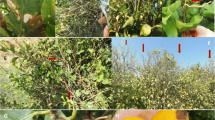Abstract
For the first time in 1989 citrus bacterial canker disease has seen on Citrus aurantiifolia in southern Iran. A total of 43 strains from affected citrus trees, ten strains from South Korea and representative from all known five pathotypes of Xanthomonas axonopodis pathogenic on citrus trees were used in this study. Isolated strains from Iran were indistinguishable by phenotypic, FAMEs, and SDS-PAGE analyses but showed different host range. First group were pathogenic on all tested citrus seedlings including C. aurantiifolia, C. limettioides, C. limon, C. jambhiri, Poncirus trifoliata X C. paradisi, C. aurantium, C. paradise, C. medica, P. trifoliate, C. grandis, C. sinensis, C. reticulate and C. sinensis X P. trifoliate. Pathogenicity of the second group were limited to C. aurantiifolia, C. limettioides, C. limon, C. jambhiri, P. trifoliata X C. paradis, and C. aurantium. Among the strains studied by AFLP fingerprinting six clusters were found. These clusters were: (1) strains of pathotype C; (2) strains of pathotypes B and D; (3) strains of pathotype A together with the main group of the Iranian strains; (4) strains isolated from Korea; (5) strains of pathotype E; and (6) seven strains from Iran which made a completely separate cluster. Strains from pathotypes B and D could not be differentiated by AFLP. The tested Iranian strains belongs to the two different groups and strains from Korea grouped as a subcluster from main cluster of Iranian strains belong to the pathotype A.


Similar content being viewed by others
Notes
Inn-Shik Myung, Overseas Pests Division, Department of Crop protection, National Institute of Agriculture Science and Technology, RDA, Suwonn 441-707, Korea.
References
Alizadeh A, Rahimian H (1989) Citrus canker in Kerman province. Iran J Plant Pathol 26:118
De Vos P, Hogers R, Bleeker M, Reijans M, Zabeau M (1995) AFLP: a new technique for DNA fingerprinting. Nucleic Acids Res 23:4407–4414
Gabriel DW, Hunter JE, Kingsley MT, Miller J, Lazo G (1988) Clonal population structure of Xanthomonas campestris and genetic diversity among citrus canker strains. Mol Plant Microbe Interact 1:59–65
Gabriel DW, Kingsley MT, Hunter JE, Gotwald T (1989) Reinstatement of Xanthomonas citri (ex Hasse) and xanthomonas phaseoli (ex Smith) to species and reclassification of all X. campestris pv. citri strains. Int J Syst Bacteriol 39:14–22
Gonzalez C, Restrepo S, Tohme J, Verdier V (2002) Characterization of pathogenic and nonpathogenic strains of Xanthomonas axonopodis pv. manihotis by PCR-based DNA fingerprinting techniques. FEMS Microbiol Lett 215:23–31
Gotwald TR, Graham JH, Civerolo EL, Barrett HC, Hearn CJ (1993) Differential host range reaction of citrus bacterial spot determined by leaf mesophil susceptibility. Plant Dis 77:1004–1009
Graham JH, Hartung JS, Chase AR (1990) Pathological, restriction fragment length polymorphism and fatty acid profile relationship between Xanthomonas campestris from citrus and noncitrus hosts. Phytopathology 80:826–836
Hartung JS, Civerolo EL (1987) Genomic fingerprinting of Xanthomonas campestris pv. citri strains from Asia, South America and Florida. Phytopathology 80:826–836
Hartung JS, Civerolo EL (1989) Restriction fragment length polymorphism distinguish Xanthomonas strains isolated from Florida citrus nurseries from X. c. pv. citri. Phytopathology 79:793–799
Janssen P, Coopman R, Huys G, Swings J, Bleeker M, Vos P, Zabeau M, Kersters K (1996) Evaluation of the DNA fingerprinting method AFLP as a new tool in bacterial taxonomy. J Gen Microbiol 142:1881–1893
Janssen P, Maquelin K, Coopman R, Tjernberg I, Bouvet P, Kersters K, Dijkshoorn L (1997) Discrimination of Acinetobacter genomic species by AFLP fingerprinting. Int J Syst Bacteriol 46:1179–1187
Khodakaramian G, Swings J, Van Eygen S, Stewaert C, Rahimian H (2000) Grouping of the strains of Xanthomonas axonopodis inducing citrus canker and spot diseases from Asia, America and Australia on the bases of protein electrophoretic pattern (SDS-PAGE) and phenotypic features (BIOLOG). Iran J Plant Pathol 36:165–178
Khodakaramian G, Swings J, Vancaneyt M, Van Eygen S (2000) Fatty acid profiles of the strains of bacteria inducing citrus canker and spot diseases by gas liquid chromatography. Iran J Plant Pathol 36:197–206
Kolliker R, Kraehenbuehl R, Boller B, Widmer F (2006) Genetic diversity and pathogenicity of the grass pathogen Xanthomonas translucens pv. graminis. Syst Appl Microbiol 29:109–119
Nesme X, Vaneechoutte M, Orso S, Hoste B, Swings J (1995) Diversity and geneticrelatedness within genera Xanthomonas and Stenotrophomonas using restriction endonuclease site differences of PCR-amplified 16s rRNA gene. Syst Appl Microbiol 18:127–135
Pitcher DG, Saunders NA, Owen R (1989) Rapid extraction of bacterial genomic DNA with guanidine thiocyanate. Lett Appl Microbiol 8:151–156
Rademaker JL, Hoste B, Louws FJ, Kersters K, Swings J, Vauterin L, Vauterin P, de Bruijn FJ (2000) Comparison of AFLP and rep-PCR genomic fingerprinting with DNA–DNA homology studies: Xanthomonas as a model system. Int J Syst Evol Microbiol 2:665–677
Restrepo S, Velez CM, Duque MC, Verdier V (2004) Genetic structure and population dynamics of Xanthomonas axonopodis pv. manihotis in Colombia from 1995 to 1999. Appl Environ Microbiol 70:255–261
Schoulties CL, Civerolo EL, Miller JW, Stall RE, Krass C, Poe SR, Ducharme EP (1987) Citrus canker in Florida. Plant Dis 71:388–395
Simoes TH, Gonçalves ER, Rosato YB, Mehta A (2007) Differentiation of Xanthomonas species by PCR-RFLP of rpfB and atpD genes. FEMS Microbiol Lett 271:33–39
Stall RE, Civerolo EL (1991) Research relating to the recent outbreak of citrus canker in Florida. Phytopathology 29:399–400
Vauterin L, Swings J, Kersters K (1991) Grouping of Xanthomonas campestris pathovars by SDS-PAGE of proteins. J Gen Microbiol 137:1677–1687
Vauterin L, Yang P, Hoste B, Vancanneyt M, Civerolo EL, Swings J, Kersters K (1991) Differentiation of Xanthomonas campestris pv. citri strains by sodium dodecyl sulfate polyacrylamide gel electrophoresis of proteins, fatty acid analysis and DNA–DNA hybridization. Int J Syst Bacteriol 41:535–542
Vauterin L, Hoste B, Kersters K, Swings J (1995) Reclassification of Xanthomonas. Int J Syst Bacteriol 46:472–489
Author information
Authors and Affiliations
Corresponding author
Rights and permissions
About this article
Cite this article
Khodakaramian, G., Swings, J. Genetic Diversity and Pathogenicity of Xanthomonas axonopodis Strains Inducing Citrus Canker Disease in Iran and South Korea. Indian J Microbiol 51, 194–199 (2011). https://doi.org/10.1007/s12088-011-0103-8
Received:
Accepted:
Published:
Issue Date:
DOI: https://doi.org/10.1007/s12088-011-0103-8




